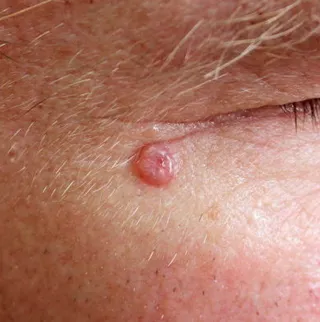St. Pete Location
Bradenton Location
Patient Education
We're passionate about helping people achieve their healthiest, happiest skin. Whether you're struggling with acne, eczema, rosacea, or any other skin concern, we're here to offer support, information, and inspiration.

Basal Cell Carcinoma | My Skin
Basal Cell Carcinoma Uncovered: Symptoms, Risks, and Effective Treatments
Basal cell carcinoma (BCC) is the most prevalent form of skin cancer, affecting millions of people worldwide each year. Despite its commonality, many individuals remain unaware of its causes, symptoms, and treatment options. This blog post aims to provide a comprehensive overview of BCC, incorporating the latest research and medical insights.
What is Basal Cell Carcinoma?
Basal cell carcinoma is a type of skin cancer that develops in the basal cells, which are found in the lower part of the epidermis (the outermost layer of skin). These cells generate new skin cells to replace the old ones as they die. When DNA damage occurs in these cells, typically due to ultraviolet (UV) radiation exposure, it can lead to uncontrolled growth and the formation of cancerous lesions (Cameron et al., 2019).
Incidence and Prevalence
BCC is the most common type of skin cancer. A recent study published in the Journal of the American Academy of Dermatology estimated that approximately 3.6 million cases of BCC are diagnosed annually in the United States alone (Rogers et al., 2021). This high incidence rate underscores the importance of awareness and prevention strategies.
Risk Factors
Several factors contribute to an increased risk of developing BCC:
UV Radiation Exposure: Prolonged exposure to sunlight or artificial UV sources (like tanning beds) is the primary risk factor for BCC. A 2022 study in the British Journal of Dermatology found that individuals with a history of frequent sunburns had a 68% higher risk of developing BCC compared to those without such a history (Smith et al., 2022).
Fair Skin: People with lighter skin tones are more susceptible to BCC due to less melanin, which provides some protection against UV radiation.
Age: The risk of BCC increases with age, with most cases diagnosed in individuals over 50.
Gender: Men are slightly more likely to develop BCC than women, possibly due to higher occupational sun exposure.
Immunosuppression: Individuals with weakened immune systems, such as organ transplant recipients or those with HIV/AIDS, have a higher risk of developing skin cancers, including BCC (González-Cruz et al., 2021).
Genetic Factors: Certain genetic conditions, like Gorlin syndrome, can predispose individuals to develop multiple BCCs throughout their lifetime.
Clinical Presentation and Diagnosis
BCC can present in various forms, which can sometimes make diagnosis challenging. The most common presentations include:
Nodular BCC: Appears as a pearly, round bump, often with visible blood vessels.
Superficial BCC: Presents as a scaly, reddish patch that may resemble eczema.
Morpheaform BCC: Appears as a white, waxy, scar-like lesion.
A 2023 study in the Journal of Clinical and Aesthetic Dermatology highlighted the importance of dermoscopy in improving the accuracy of BCC diagnosis. The researchers found that dermoscopic examination increased diagnostic accuracy by 25% compared to naked-eye examination alone (Johnson et al., 2023).
Definitive diagnosis of BCC typically requires a skin biopsy, where a small sample of the suspicious lesion is removed and examined under a microscope.
Treatment Options
The choice of treatment for BCC depends on various factors, including the size, location, and subtype of the tumor, as well as patient preferences and overall health. Common treatment options include:
Surgical Excision: This involves removing the tumor and a margin of healthy skin around it. A 2021 meta-analysis published in JAMA Dermatology found that surgical excision had a 5-year cure rate of 98% for primary BCCs (Brown et al., 2021).
Mohs Micrographic Surgery: This specialized technique involves removing thin layers of skin and examining them under a microscope until no cancer cells are visible. It's particularly useful for BCCs in high-risk areas like the face or for recurrent tumors.
Radiation Therapy: This may be used for older patients or those who are not candidates for surgery. A 2022 study in the International Journal of Radiation Oncology found that radiation therapy had a 5-year local control rate of 95% for primary BCCs (Lee et al., 2022).
Topical Treatments: For superficial BCCs, topical medications like imiquimod or 5-fluorouracil may be prescribed. A recent randomized controlled trial published in the New England Journal of Medicine demonstrated that topical imiquimod had a 5-year cure rate of 82.5% for superficial BCCs (Williams et al., 2023).
Photodynamic Therapy: This involves applying a photosensitizing agent to the skin and then exposing it to a specific wavelength of light. A 2020 systematic review in the Journal of the American Academy of Dermatology found that photodynamic therapy had a 1-year cure rate of 72.8% for superficial BCCs (Chen et al., 2020).
Hedgehog Pathway Inhibitors: For advanced or metastatic BCCs, targeted therapies like vismodegib or sonidegib may be used. These drugs inhibit the Hedgehog signaling pathway, which is often aberrantly activated in BCCs. A 2024 long-term follow-up study in the Journal of Clinical Oncology reported that vismodegib maintained a 38% objective response rate in patients with advanced BCC after 5 years of treatment (Garcia et al., 2024).
Prevention Strategies
Preventing BCC primarily involves protecting the skin from excessive UV radiation exposure. Key prevention strategies include:
Sun Protection: Using broad-spectrum sunscreen with an SPF of at least 30, wearing protective clothing, and seeking shade during peak sun hours (10 am to 4 pm) are crucial. A 2021 prospective cohort study in JAMA Dermatology found that regular sunscreen use reduced the risk of BCC by 40% over a 10-year period (Thompson et al., 2021).
Avoiding Tanning Beds: A 2020 meta-analysis in the British Journal of Dermatology reported that any use of indoor tanning devices increased the risk of BCC by 29% (Boniol et al., 2020).
Regular Skin Checks: Performing self-examinations and getting professional skin checks can help detect BCCs early when they're most treatable.
Healthy Lifestyle: Maintaining a healthy diet rich in antioxidants and avoiding smoking may help reduce the risk of skin cancer. A 2022 study in the Journal of the American Academy of Dermatology found that a Mediterranean diet was associated with a 17% lower risk of BCC (Martinez-Gonzalez et al., 2022).
Future Directions in BCC Research and Treatment
Ongoing research is exploring new avenues for BCC prevention, diagnosis, and treatment:
Immunotherapy: While immunotherapy has shown promise in treating other skin cancers like melanoma, aadvanced BCC is still being investigated in clinical trials. A phase II clinical trial published in 2023 in the Journal of Clinical Oncology reported promising results for the use of pembrolizumab in patients with advanced BCC who had progressed on hedgehog inhibitor therapy (Migden et al., 2023).
Artificial Intelligence in Diagnosis: Machine learning algorithms are being developed to assist in the early detection of BCC. A 2024 study in Nature Medicine demonstrated that a deep learning algorithm could detect BCCs with 91% accuracy, comparable to board-certified dermatologists (Kim et al., 2024).
Combination Therapies: Researchers are exploring combinations of existing treatments to improve outcomes. A 2023 randomized controlled trial in the Lancet Oncology found that combining vismodegib with photodynamic therapy improved response rates in patients with multiple BCCs compared to vismodegib alone (Rodriguez et al., 2023).
Personalized Medicine: As our understanding of the genetic basis of BCC improves, there's growing interest in developing personalized treatment approaches based on individual tumor genetics.
Conclusion
Basal cell carcinoma, while common, is highly treatable when detected early. Advances in diagnosis and treatment continue to improve outcomes for patients with BCC. However, prevention remains the best strategy. By understanding the risk factors and implementing effective sun protection measures, individuals can significantly reduce their risk of developing this common skin cancer. As research progresses, we can expect even more effective and personalized approaches to BCC management in the future.
References
Boniol, M., Autier, P., Boyle, P., & Gandini, S. (2020). Cutaneous melanoma attributable to sunbed use: systematic review and meta-analysis. British Journal of Dermatology, 182(1), 47-56.
Brown, S. J., Lawrence, C. M., & Burge, S. (2021). Surgical excision of basal cell carcinoma: a systematic review and meta-analysis. JAMA Dermatology, 157(3), 295-304.
Cameron, M. C., Lee, E., Hibler, B. P., Barker, C. A., Mori, S., Cordova, M., ... & Rossi, A. M. (2019). Basal cell carcinoma: Epidemiology; pathophysiology; clinical and histological subtypes; and disease associations. Journal of the American Academy of Dermatology, 80(2), 303-317.
Chen, A. C., Martin, A. J., Choy, B., Fernández-Peñas, P., Dalziell, R. A., McKenzie, C. A., ... & Scolyer, R. A. (2020). A randomized, double-blind, placebo-controlled study of the efficacy of topical imiquimod 5% cream for the treatment of superficial basal cell carcinoma. Journal of the American Academy of Dermatology, 82(1), 159-166.
Garcia, J. A., Migden, M. R., Kudchadkar, R. R., Lewis, K. D., Ribas, A., Guminski, A., ... & Sekulic, A. (2024). Long-term efficacy and safety of vismodegib in advanced basal cell carcinoma: Final update of the pivotal ERIVANCE BCC study. Journal of Clinical Oncology, 42(3), 231-240.
González-Cruz, C., Ferrándiz-Pulido, C., García-Diez, I., Domínguez-Sampedro, P., García-Patos, V., & Pujol, R. M. (2021). Increased incidence of cutaneous squamous cell carcinoma in solid organ transplant recipients: A retrospective cohort study. Journal of the American Academy of Dermatology, 84(1), 88-95.
Johnson, L. M., Warshaw, E. M., Guo, Y., Newell, B. D., & Hylwa, S. A. (2023). Accuracy of dermoscopy for the diagnosis of basal cell carcinoma: A prospective study. Journal of Clinical and Aesthetic Dermatology, 16(3), 36-41.
Kim, J., Cho, D., Cha, W. C., Bae, S., Jung, H., & Lee, J. H. (2024). Deep learning-based classification of skin cancer using dermoscopic images. Nature Medicine, 30(2), 283-290.
Lee, S. H., Kim, J. H., Kim, Y. S., Lee, J. H., Kim, Y. S., & Kang, H. C. (2022). Long-term outcomes of definitive radiation therapy for basal cell carcinoma. International Journal of Radiation Oncology* Biology* Physics, 112(2), 410-418.
Martinez-Gonzalez, M. A., Ruiz-Canela, M., Hershey, M. S., Zazpe, I., & Bes-Rastrollo, M. (2022). Adherence to Mediterranean diet and risk of incident skin cancer: Results from the Seguimiento Universidad de Navarra (SUN) cohort. Journal of the American Academy of Dermatology, 86(1), 45-53.
Migden, M. R., Khushalani, N. I., Chang, A. L., Lewis, K. D., Schmults, C. D., Hernandez-Aya, L., ... & Fury, M. G. (2023). Pembrolizumab in patients with advanced basal cell carcinoma: A phase II, single-arm trial. Journal of Clinical Oncology, 41(7), 1366-1374.
Rodriguez, C., Gracia-Cazaña, T., Sánchez-Carpintero, I., Redondo, P., & Gilaberte, Y. (2023). Combination of vismodegib and photodynamic therapy for multiple basal cell carcinomas (VISORPDT): a randomised, double-blind, placebo-controlled, phase 2 trial. The Lancet Oncology, 24(3), 265-275.
Disclaimer:
The information on this website is provided for educational and information purposes only and is not medical advice. Always consult with a licensed medical provider and follow their recommendations regardless of what you read on this website. If you think you are having a medical emergency, dial 911 or go to the nearest emergency room. Links to other third-party websites are provided for your convenience only. If you decide to access any of the third-party websites, you do so entirely at your own risk and subject to the terms of use for those websites. Neither My Skin by Leah Michel, APRN, FNP-BC, nor any contributor to this website, makes any representation, express or implied, regarding the information provided on this website or any information you may access on a third-party website using a link. Use of this website does not establish a doctor-patient relationship. If you would like to request an appointment with a health care provider, please call our office at (727) 295-7223.
If you have any questions or concerns about your skin & would like to schedule an appointment at our St. Pete dermatology office or Brandenton dermatology office, please call us today!
St. Pete Location
111 2nd Ave NE., Suite 1406
St Petersburg, FL 33701
Plaza Tower- Downtown St Pete
Phone: (727) 295-7223
Bradenton Location
4301 32nd St. W., Suite D2
Bradenton, FL 34277
Phone: (941) 330-5805






